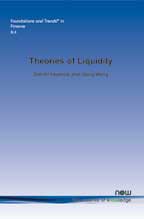Theories of Liquidity
By Dimitri Vayanos, London School of Economics, CEPR and NBER, UK, d.vayanos@lse.ac.uk | Jiang Wang, Massachusetts Institute of Technology, CAFR and NBER, USA, wangj@mit.edu
Abstract
We survey the theoretical literature on market liquidity. The literature traces illiquidity, i.e., the lack of liquidity, to underlying market imperfections. We consider six main imperfections: participation costs, transaction costs, asymmetric information, imperfect competition, funding constraints, and search. We address three questions in the context of each imperfection: (a) how to measure illiquidity, (b) how illiquidity relates to underlying market imperfections and other asset characteristics, and (c) how illiquidity affects expected asset returns. We nest all six imperfections within a common, unified model, and use that model to organize the literature.
Theories of Liquidity
Theories of Liquidity surveys the theoretical literature on market liquidity focusing on six main imperfections studied in that literature: participation costs, transaction costs, asymmetric information, imperfect competition, funding constraints, and search. The authors address three basic questions in the context of each imperfection: (a) how to measure illiquidity, i.e., the lack of liquidity, (b) how illiquidity relates to underlying market imperfections and other asset characteristics, and (c) how illiquidity affects expected asset returns. The theoretical literature on market liquidity often employs different modeling assumptions when studying different imperfections. Instead of surveying this literature in a descriptive manner, Theories of Liquidity uses a common, unified model to study all six imperfections that are considered, and for each imperfection addresses the three basic questions within that model. The model generates many of the key results shown in the literature. It also serves as a point of reference for surveying other results derived in different or more complicated settings, and for describing fruitful areas for future research. This survey is related to both market microstructure and asset pricing. It emphasizes fundamental market imperfections covered in the market microstructure literature, and examines how these relate to empirical measures of illiquidity used in that literature. It also examines how market imperfections affect expected asset returns - an asset-pricing exercise - and, in that sense, connects the two areas of research.
